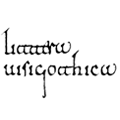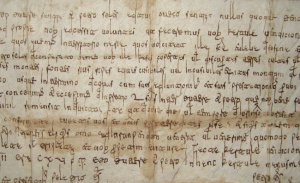Types of Visigothic script (I): the speed of strokes
There are many different types of Visigothic script. How to differentiate and name them?
Now that we all know how Visigothic script ended up being called that way, it is time to revise its types, meaning in which different executions it can be found.
If you are a frequent reader of this blog, you may already know that Visigothic script has two main typological variants, cursive and minuscule, but this is not the only basic classification that can be applied to the script nor the only typological variants that were used by its scribes. As with any other script, Visigothic script can be externally described by:
- its degree of perfection,
- its detail or speed when traced,
- the stage or degree of its evolution,
- and the accuracy in keeping its alphabet and abbreviations to the canon.
These considerations regarding the execution of the script are, unfortunately, a bit subjective, thus being difficult to explain quantitatively even though the extremes are easily distinguished. However, anyone who can describe the script in as much detail as to include all these different considerations is also familiar with the cultural context to which each one corresponds. Among specialists, the “subjectivity” is not as confusing as you might think.
Types of Visigothic script considering the speed of strokes
The typological variants of Visigothic script that can be distinguished bearing in mind the speed with which the script was traced are the easiest to recognise and, therefore, the types that are most commonly used. In general, when you hear/read about typological variants without further specification, this is the criterion the scholar is following. There are two main types, cursive and minuscule:
Visigothic cursive is the one which is drawn, in general, the fastest. That does not mean it was written carelessly. If you look at the image below, can you imagine how difficult it must have been to use all these ligatures and nexuses, to develop all those ascenders and descenders, if doing it quickly? There are different levels of “perfection” as will be discussed. If a scribe was using the cursive variant, the result can be a total mess, writing quickly and sloppily, but it can also be a perfect beauty; it depends on how good the scribe was.
This variant was the one used mostly for writing charters – in the early centuries of the Middle Ages, cursive writing for legal issues meant a direct link with the scriptural tradition of the late Roman empire –, but it was also used for codices, although very few have been preserved. And yes, if you are thinking about the context, we know that some scribes who were able to use different variants decided which one they wanted to use, not only considering the product (charter or codex) but also the institution or person issuing the document and to whom it was addressed.
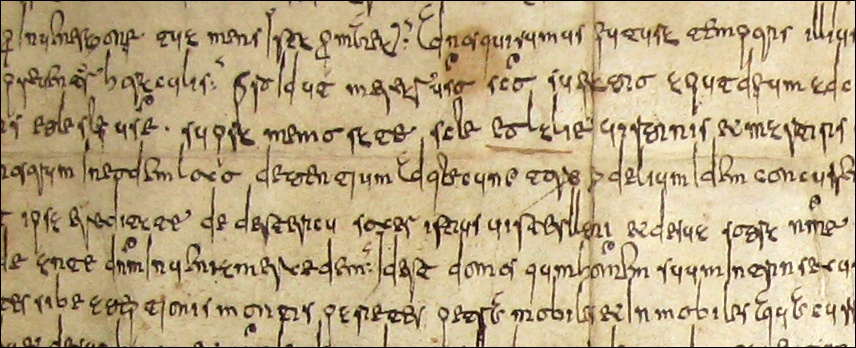 © Ainoa Castro Correa - Lugo, Archivo de la Catedral, legajo 2, nº 3. Example of Visigothic cursive script.
© Ainoa Castro Correa - Lugo, Archivo de la Catedral, legajo 2, nº 3. Example of Visigothic cursive script.
Visigothic minuscule is the one which is drawn slowly. Again, that does not necessarily mean it was written with more care than cursive, just that the script has other graphic characteristics, few nexuses and even fewer ligatures, that allow it to be written less quickly.
When we are using the speed to classify the script we are not talking about the speed the scribe decided to work with but that which the script tolerates. You cannot draw cursive ligatures stroke by stroke, slowly, but you can write minuscule ligatures taking all the time in the world without problems. Of course, if the scribe was well-trained, his minuscule will be more “cursive” as for quicker than the one used by a neophyte who was not yet completely familiar with the features he was using.
It can really sound confusing, and indeed it is just having in mind the speed, which is why it is important to consider the other types of describing the script too – by perfection, evolution and accuracy to the canon. In contrast with the previous variant, minuscule was the one preferred for writing codices, as it was also the characteristic variant for some regional variants, but that will be another topic.
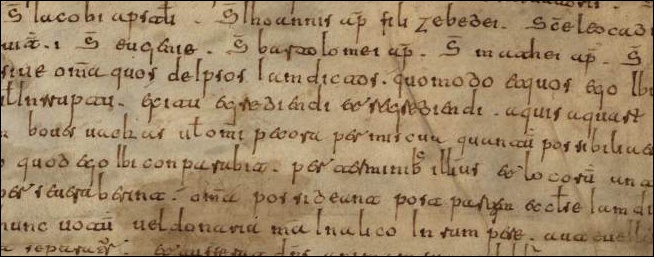 © Madrid, Archivo Histórico Nacional, Sección Clero, carp. 1325B, nº 5. Example of Visigothic minuscule script.
© Madrid, Archivo Histórico Nacional, Sección Clero, carp. 1325B, nº 5. Example of Visigothic minuscule script.
These two are the main typological variants, but there are also some variants in between…
First, there is the semi-cursive variant that, as its name suggests, is a mix between cursive and minuscule. It is difficult to explain with words as it is neither fast nor slow, and it is also difficult to place it in its cultural context. We can think about scribes who were not well trained in any one variant although they were good enough in both, scribes who did not belong to a main production centre with a well-known school but to a small centre, maybe a small monastery or a parochial church. The semi-cursive variant is difficult to study, although it can be extremely useful in analysing cultural contacts among centres, and for studying the process of education itself.
 © Ainoa Castro Correa - Lugo, Archivo de la Catedral, 26. Example of Visigothic semi-cursive script.
© Ainoa Castro Correa - Lugo, Archivo de la Catedral, 26. Example of Visigothic semi-cursive script.
Another typological variant is the so-called elongate, a cursive written very carefully with increasing ascenders and descenders, which has a genetic origin a bit different from the other typological variants.
Elongate is the medieval Visigothic interpretation of the script that was used in and for the Visigothic chancery, and it looks, in its more pure form, similar to Merovingian script (externally and looking from afar). It is an elegant script that, losing its meaning a bit, was used within Visigothic script texts to highlight some important parts such as titles, first lines with a verbal invocation, names of kings, etc. There are also some surviving charters, although very few, that were written entirely by using this variant; one codex too. If you see this script in a charter, you can be sure the scribe was a good well-trained one who wanted to catch your attention in those specific parts of the texts, and that he was aware that this script was used especially for that purpose, although it is likely that it was no longer known why.
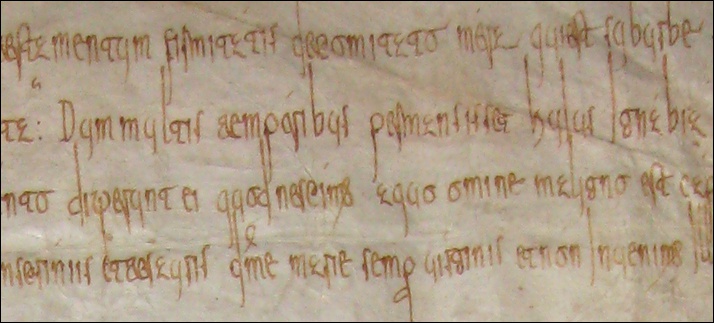 © Ainoa Castro Correa - Lugo, Archivo de la Catedral, legajo 2, nº 7. Example of Visigothic elongate script.
© Ainoa Castro Correa - Lugo, Archivo de la Catedral, legajo 2, nº 7. Example of Visigothic elongate script.
Finally, we can also consider the scripts in transition to Caroline minuscule as a typological variant. Thus, there is cursive towards Caroline, and minuscule towards Caroline, and semi-cursive towards Caroline (luckily, I have not seen elongate in transition to Caroline…).
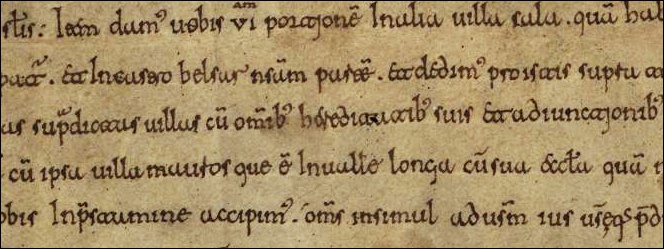 © Madrid, Archivo Histórico Nacional, Sección Clero, carp. 1325C, nº 7. Example of Visigothic minuscule in transition to Caroline minuscule script.
© Madrid, Archivo Histórico Nacional, Sección Clero, carp. 1325C, nº 7. Example of Visigothic minuscule in transition to Caroline minuscule script.
All these typological variants have different alphabets, abbreviations, signs for abbreviations, general signs of abbreviation, their own graphic evolution and even their own system of punctuation! That is right, you may think Visigothic is more or less the same, being cursive or minuscule, but the truth is that both are very different scripts, not only in their execution but also in their uses and cultural context. They even have two different genetic origins, but that is also a topic for another time.
>>> Read part II: Types of Visigothic script: perfection, evolution and canon <<<
by A. Castro
[edited 12/07/2018]
